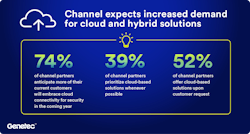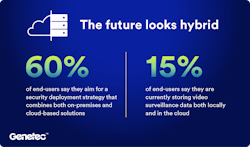MONTRÉAL, November 29, 2023 — Genetec Inc. (“Genetec”), a leading technology provider of unified security, public safety, operations, and business intelligence solutions, today shared the results of its 2024 State of Physical Security report. Based on insights from over 5,500 physical security leaders worldwide (including end users and channel partners), the report looks at the security strategies organizations are putting in place to effectively navigate the realities of a changing industry.
Cloud adoption is picking up speed
The adoption of cloud-based solutions for physical security has been gradually increasing over the past decade, but it is now picking up speed. According to the survey, 44% of end users reported that more than 25% of their physical security setups are now either in the cloud or use a combination of cloud and on-premises solutions. This is a significant jump from the 24% reported in last year's survey.
"Transitioning to the cloud doesn’t have to happen all at once," said Despina Stamatelos, Senior Commercial Manager, Genetec, Inc. "Moving one site over at a time or using a cloud-connected appliance to get existing infrastructure cloud-ready can happen in a phased approach. Organizations can gradually adopt the cloud by leveraging its benefits in areas that add value to their business and in a gradual and organic way so it's not disruptive, resource-heavy, or costly.
Additionally, organizations can use a hybrid approach in moving to the cloud. In fact, more and more organizations are taking this route. We’re seeing a shift in the market whereby a greater percentage of security systems are now being deployed either in the cloud or hybrid versus on-premises. This indicates that end users don’t want to be locked in and are seeking options when leveraging cloud technology to optimize their infrastructure.
Hybrid-cloud deployments allow organizations to transition to the cloud at their pace and based on their unique business needs. They provide an easy path to cloud benefits without getting locked into proprietary solutions while enabling them to keep some infrastructure on-premises for added storage, processing power, and bandwidth optimization. With hybrid-cloud infrastructure, organizations can manage and operate all their on-prem and cloud systems using one single unified platform. This simplifies setup, training, and operations, ensuring teams can efficiently handle daily tasks."
Cyber concerns about the cloud are diminishing
Cyber concerns about cloud-based solutions are lessening significantly. In last year's survey, end-users considered perceived cybersecurity risks to be the primary factor discouraging their organizations from adopting cloud-based security systems. However, there seems to be a shift in attitudes. This shift underscores growing confidence in the capabilities of cloud solution providers to establish robust cybersecurity measures. As a result, in the 2024 survey, respondents have relegated perceived cybersecurity risks to the sixth position among the factors deterring their organizations from adopting security systems in the cloud.
"A few factors are driving the shift towards cloud adoption," added Stamatelos. "These include a greater involvement of IT specialists in managing security systems, a decrease in cybersecurity concerns and an increase in OPEX budgets.
More than ever IT specialists are involved in both the decision-making process of procuring a new security system, but also in managing the system once deployed. Many of these IT specialists have a mandate or plan on moving their systems into the cloud. Hence, they’re heavily influencing the adoption of cloud solutions.
We’re also seeing a decrease in cybersecurity concerns associated with cloud-based solutions. In the 2022 survey end users ranked cybersecurity risks as the top reason for deterring their organization from adopting cloud solutions. In the 2023 survey, this dropped down to 6th place, indicating that attitudes are changing rapidly. This changing mindset signals an increasing trust in the ability of cloud solution providers to implement effective cybersecurity measures.
Finally, we are seeing a continued increase in OPEX budgets. 62% of end users expect budgets to increase or remain flat into 2024 and only 15% expect budgets to decline. With many cloud solutions being charged on a recurring basis, we foresee some of the OPEX budget being tied to cloud or hybrid-cloud security systems."
Channel expects increased demand for cloud and hybrid solutions
Feedback from channel partners also supports the idea that end-users are eagerly shifting towards cloud solutions. A substantial 74% of channel partner respondents anticipate that more of their current customers will embrace cloud connectivity for security in the coming year. Furthermore, 39% of channel partners stated that they prioritize cloud-based solutions whenever possible, and an additional 52% offer cloud-based solutions upon customer request.
IT and physical security departments are increasingly interconnected
The increasing adoption of cloud-based physical security systems has led to a rise in cybersecurity threats, data handling, and compliance requirements. As a result, IT and physical security teams are becoming increasingly interconnected as evidenced by 55% of end users indicating that the IT department has access to physical security data. As technology adoption grows and remote access from external networks becomes more common, the partnership between IT and physical security will continue to develop.
"The interconnectedness of IT and physical security departments has been going on for a few years now, and as the demand for unified, cloud-connected physical security solutions continues to grow, we foresee continued interdepartmental convergence, with organizations looking for ways to optimize collaboration between IT and physical security teams," finished Stamatelos. "This will give teams a comprehensive view of systems and evolving risks while helping them extract more value from data."
"Bridging these two valuable skill sets will result in more effective risk mitigation and data optimization across the business. Already, we are seeing physical security leaders increasingly integrating IT expertise into their departments. Simultaneously, Security Operations (SecOps) are broadening their function to address physical security risks, leveraging data from both groups. IT will bring physical security within their group and begin overseeing physical security mandates."
The future looks hybrid
It appears that most organizations will prefer a hybrid approach, combining both on-premises and cloud-based solutions. 60% percent of end-user respondents revealed that their organizations aim for a security deployment strategy that combines both. The transition to hybrid systems is already in progress, with 15% of end-users stating that their organizations are currently storing video surveillance data both locally and in the cloud, marking a notable increase from the 4% reported in last year's survey.
“A hybrid cloud deployment clearly emerges as the ideal path forward for many organizations, seamlessly blending local infrastructure with the power of the cloud," said Christian Morin, Vice President Product Engineering / Chief Security Officer at Genetec Inc. "With a hybrid-cloud solution, organizations can optimize their physical security installation to best fit their business. And no matter how their security needs evolve, their systems will remain agile and adaptable to continue providing them with the capabilities they require.”
Survey methodology
Genetec Inc. surveyed physical security professionals from August 21 to September 15, 2023. Following a review of submissions and data cleansing, 5,554 respondents (including both end users and systems integrators) were included in the sample for analysis. Survey samples were run across all regions including North America, Central America, Caribbean, South America, Europe, Middle East, Africa, East Asia, Southern Asia, South-Eastern Asia, Central Asia, Western Asia, and Australia-New Zealand.
To download a full copy of the report, please go to: https://www.genetec.com/a/physical-security-report.






